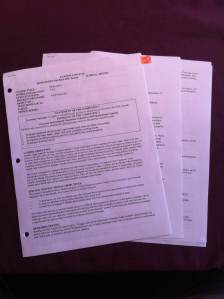
These ancient pornographic jugs from Peru were on display in Montreal last year – unfortunately, I couldn’t find a way to work them into my lecture.
As of today, I have given “the talk” in two out of three of my Gendered World Views classes. I’m not going to lie, it’s not been a comfortable conversation, but the experience of teaching students what feminists have said about pornography (and why), has been surprisingly rewarding. While I do not show any provocative images, my lecture does include reference to Catherine MacKinnon’s famous claim that: “Man fucks woman. Subject, verb, object.” Moreover, students get to listen to Andrea Dworkin’s very passionate and explicit testimony to the Attorney General on Pornography, so it’s not exactly PG either.
So, how have I decided to navigate this treacherous territory, and has it been working so far? Well, as you know from last week’s blog post, I really and truly believe that it’s important to discuss this material, but I was pretty panicked about whether or not I would be able to pull it off in a respectful and productive way. My main goal was to explain the feminist sex wars, then and now, and to make students reflect on the pornographic content that I was pretty sure they were all watching – and which, if I had to guess, they had been watching for quite some time.
Originally, I was going to take a strictly chronological approach, and start with the second wave, bringing it forward to the current controversy in roughly an hour and a half. But the more I thought about it, the more I realized that doing it that way might alienate students, who tend to be uncomfortable with the second wave. A strictly chronological approach also didn’t afford me any opportunity to get a sense of their familiarity with – or thoughts about – pornography.
In the end, then, I decided to start with a modern case study, then go back to the beginning and work my way forward again. I showed 8 minutes of the Belle Knox interview on CNN – where the so-called “Duke Porn Star” defends her choice to become a sex worker and reiterates the initial arguments she made on xoJane. While my students were watching this, I asked them to complete an anonymous paper survey that I had handed out as they walked in. It asked:
1) Do you watch porn?
2) If you answered yes, do you like it?
3) Do you feel guilty after watching porn?
Why the paper survey, you ask? First and foremost, I wanted to get of sense of whether or not my students do indeed watch pornography. The answer to the first question would determine if I could move right into feminist responses to porn, or if I had to explain a little about what porn looked like first. All three questions taken together were designed to provide me with evidence that there was no one single experience that defined people’s relationship to porn. Expressions of guilt also signaled that there might be something to feel guilty about (well, that, and the fact that our society remains generally uncomfortable with sex).
As I handed out those paper surveys, students reacted in a number of ways. Unsurprisingly, many of my male students laughed and asked if I really believed that anyone in the room didn’t watch porn. I cautioned them not to rush to judgment, especially as other students (both male and female) recoiled or expressed shock when I handed them that little 3”x3” survey.
After the Belle Knox interview was over, I collected the surveys, and asked students to get into groups of 3 or 4, so that they’d have a little more privacy. I encouraged them to move around the room to find the other people that they felt most comfortable with, and assured them that they could get into all-male or all-female groups if they wanted. Then I asked them to figure out if doing pornography could ever be a feminist act. Silence.
Eventually, conversation picked up, and students in both my classes started asking each other the hard questions. What matters more, the individual choice or the system in which the person is making that choice? What type of porn are we talking about? Has anyone decided on what feminism “is” yet anyway? And so on, and so forth… I was both relieved and impressed.
When we came back into the large group, I explained to students that this would be the one class where I didn’t expect anyone to talk. The material that I had planned to pair with the porn lecture was much more interactive, and they could relax until then if they so desired. There was absolutely no pressure to comment throughout my lecture on pornography, but I would open the floor from time to time and they could comment if they wanted to.
In my first class, no one wanted to go there, not even some of my more outgoing male students who wanted to discuss their thoughts about the survey very loudly before class began. Small-group discussions had made everyone aware of the diversity of opinion in the room, and students seemed to sense that perhaps this was treacherous terrain. My second group, however, was less interested in small group and more interested in speaking as a class. The discussion was dominated by men, who felt more secure speaking about sexuality, but all of them – even the comedians – were serious, respectful, and reflective.
In order to fill the silence in the first class, and to augment the conversation in the second, I informed students that between one quarter and one third of their peers didn’t watch porn (at least not regularly enough to answer “yes”). More importantly, I told them, between one quarter and one third of those who did watch, felt guilty after consuming it. “Why might that be,” I mused, as I segued into the fraught female relationship with pornographic content.
From there it was pretty smooth sailing. Second-wave sex wars and the concept of rape culture. Dworkin and MacKinnon’s battle with, and eventual loss to, the sex-positive feminists. The rise of new technologies and new debates about the globalization of the sex trade. The issue of consent and the alleged growth in violent content. And the question of structure versus independent choice. To make the modern section a little less heavy, I included some less jargon-ridden and more pop-culture focused material, like a nod to the Good For Her Feminist Porn Awards, and a brief explanations of the anti-porn concern about porn addiction and erectile dysfunction among young men.
That brought us to the break (I currently teach night school in 3-hour blocks), and I closed off discussion by asking if anyone wanted to take a stab at deciding which group of feminists had it right. By that point, no one in either class wanted to attempt answering such a question, and they all needed a little time to process. So off they went.
After the break I talked about rape culture in the mainstream media as a way of tying things back to the same arguments without continuing on with a conversation about pornography that made many students feel uncomfortable. No one likes to think about rape, but at least everyone felt they could be more objective and retain a healthier distance from the subject… well, at least for the first 15 minutes or so. The more we brainstormed about ads, music, and video games, the more everyone started to feel a little more caught up in the system once again.
What really impressed me was that at the end of what was an undeniably exhausting class, one of my students put up his hand and said that he had decided that society needs to hear more about sex-positive feminism and feminist porn. The reason, he explained, was that he agreed with Andrea Dworkin and fundamentally believed that men were learning about sexuality from porn. From there, he moved to the sex positive position and claimed that people are always going to watch porn, probably from a young age. If porn is unhealthy, then male sexuality becomes unhealthy as well. Thus, if we want men and women to have healthier sexual experiences, we need to show them a healthier spectrum of what sexuality is so that they become healthier adults.
Other students told me that they never imagined that they would be talking about pornography in a classroom, but that it was a really important topic. And for the first time, I felt like I had managed to make a reluctant group of students interested in what are usually very unpopular feminist debates. I’m sure I didn’t reach them all, but I still feel like all my work and anxiety has been worthwhile. If even 10% of those students start to think more critically about sexuality and the sexually explicit material they consume, then I’ve done something valuable. I think we were all uncomfortable last week, but discomfort is the starting point of so much important intellectual work.


